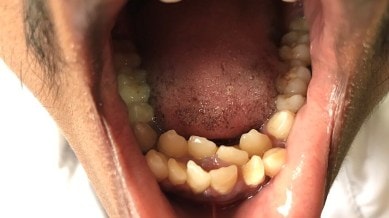📣 For more lifestyle news, click here to join our WhatsApp Channel and also follow us on Instagram
This rare condition left an 11-year-old with 81 teeth; dentist says ‘most people don’t realise until…’
In most cases of hyperdontia, extra teeth are positioned at the upper front jaw, where they grow as a "small, peg-shaped tooth known as a mesiodens

The human body is utterly fascinating. Whenever science serves us the idea that we’ve figured it out, boom comes another medical rarity. One such case, which has yet again left Homo sapiens shocked, is that of an 11-year-old from Brazil who has 81 teeth. Yes, you read that right. The probability of having a tooth or two extra than the usual set of 32 teeth, medically termed as hyperdontia, is in itself very low. This makes the Brazilian case almost miraculous, as per the Dentistry Journal, whose 2025 data has made it clear that the chances of having three or more extra teeth are extremely rare, ranging from one in 10,000 to one in a million individuals, depending on sample size. Curious, we reached out to Dr Ramakrishna, BDS, MDS, MOI, Founder Dental Profiles, Bangalore, to understand everything there’s to know about hyperdontia.
Q1: What exactly is hyperdontia, and how is it diagnosed?
Hyperdontia simply refers to having extra teeth, that is, more than the usual 20 baby teeth or 32 permanent adult teeth. These extra supernumerary teeth can pop up anywhere in the mouth. In most cases, they are positioned at the upper front jaw, where they grow as a “small, peg-shaped tooth known as a mesiodens.” Interestingly, most people, as the medical expert points out, don’t realise they have hyperdontia until a dentist notices something unusual, like a delay in permanent tooth eruption, crowding, or an odd spacing pattern. However, actual diagnosis comes through dental X-rays or 3D scans. “Hyperdontia isn’t just about aesthetics or crowding. It can sometimes signal deeper genetic conditions like Cleidocranial Dysplasia or Gardner’s Syndrome, which is why dentists often take a full medical history alongside imaging,” Dr Ramakrishna notes.
Q2: Are these extra teeth usually functional, or do they cause complications?
Extra teeth rarely serve a useful purpose, says Dr Ramakrishnan, adding that these are often misshapen, poorly aligned, or completely stuck under the gumline. “They can cause quite a bit of trouble by pushing surrounding teeth out of position, blocking permanent teeth from erupting, and even causing bite issues (what we call malocclusion). In some cases, cysts or infections can develop around them, and when visible, especially in the front, they may affect both speech clarity and self-esteem, he reveals. The doctor further explains that in most cases, supernumerary teeth never erupt on their own. “They often sit in the jawbone silently until they start interfering—at which point, they’re no longer just an extra tooth, but a full-blown dental complication.”
Q3: How many extra teeth can a person have? Is it true someone had 81 teeth?!
Most people with hyperdontia have just one or two extra teeth, and when it is more than five, in extremely rare cases, there’s often a connection with a syndrome. Referring to the aforementioned case, Dr Radhakrishna explains that the 81 tooth-like structures were surgically removed from he jaw “This wasn’t traditional hyperdontia, though—it was a compound odontoma, a type of benign tumour made of miniature tooth elements.”
He reveals that such cases are exceptionally rare, with fewer than 1% cases involving multiple extra teeth. Such cases typically require a team of specialists for long-term management and highlight how powerful early screening can be, before things take an extreme turn.
Q4: How is hyperdontia treated?
Dr Ramakrishna tells indianexpress.com that the treatment depends on how many extra teeth there are and whether they’re causing trouble. Some important factors to be taken into account are when these extra growths are crowding other teeth, blocking a permanent tooth or causing pain, infection, or visible aesthetic concerns. “Surgical removal is usually the go-to solution.” In children and teens, dentists often recommend orthodontic treatment afterwards to align the remaining teeth properly and guide the jaw’s natural development.
In cases where the extra teeth aren’t causing problems, for instance, if they’re deeply buried and asymptomatic, regular monitoring with X-rays works fine. “That said, most professionals err on the side of caution because these teeth tend to become problematic later. Treatment usually involves a team: oral surgeon + orthodontist + general dentist to ensure nothing slips through the cracks,” Dr Ramakrishna notes.
Q5: What happens if hyperdontia is left untreated?
Dr Radhakrishna warns that letting extra teeth sit untreated can lead to many oral health problems, such as
-
Crowded, misaligned teeth that affect your smile and bite
-
Impacted permanent teeth that never erupt or come out in the wrong spot
-
Malocclusion that leads to jaw discomfort or TMJ problems
-
Hygiene challenges, since overlapping or tightly spaced teeth are harder to clean
-
Speech issues or confidence dips, especially in children or teens”
Story continues below this ad
He further adds that untreated dental anomalies often lead to a lower quality of life, especially in adolescents who struggle with self-image and oral function. “So while hyperdontia might sound harmless at first, the long-term impacts can be significant—both physically and emotionally. The earlier it’s caught, the better the outcome,” he concludes.
DISCLAIMER: This article is based on information from the public domain and/or the experts we spoke to. Always consult your health practitioner before starting any routine.
📣 For more lifestyle news, click here to join our WhatsApp Channel and also follow us on Instagram